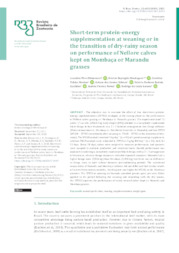Short-term protein-energy supplementation at weaning or in the transition of dry-rainy season on performance of Nellore calves kept on Mombaça or Marandu grasses.
Short-term protein-energy supplementation at weaning or in the transition of dry-rainy season on performance of Nellore calves kept on Mombaça or Marandu grasses.
Author(s): BITENCOURT, L. P.; MONTAGNER, D. B.; MARINO, C. T.; DIFANTE, G. DOS S.; EUCLIDES, V. P. B.; NEVES, A. P.; GOMES, R. da C.
Summary: ABSTRACT - The objective was to examine the effect of two short-term proteinenergy supplementation (STPES) strategies at the rearing phase on the performance of Nellore calves grazing on Mombaça or Marandu grasses. The experiment used 72 calves (7-mo old, 229±3.0 kg body weight [BW]) allotted in a completely randomized block design to four treatments in a 2 × 2 factorial arrangement: two forage cultivars (Panicum maximum cv. Mombaça vs. Brachiaria brizantha cv. Marandu) and two STPES (WEAN – STPES immediately after weaning vs. TRAN – STPES in the transition of dryrainy). The WEAN animals received 1 kg day?1 (n = 36) of a protein-energy supplement, whereas TRAN animals were subjected to STPES at 2 g/kg BW day?1 (n = 36), both for 53 days. Every 28 days, calves were weighed to measure performance, and pastures were sampled to evaluate productive and structural traits. Growth performance was analyzed considering a completely randomized block design with a 2 × 2 arrangement of treatment, whereas forage responses included repeated measures. Marandu had a higher forage mass (3,586 kg) than Mombaça (2,890 kg), but there was no difference in forage mass in each cultivar between preconditioning periods. The nutritional composition of Marandu and Mombaça cultivars did not differ and had similar results of in vitro fermentation variables. Stocking rate was higher for WEAN, in the Mombaça pastures. The STPES at weaning on Marandu provided greater gains per area. When applied in the period following the weaning and coinciding with the dry season, the STPES improves the performance of newly weaned calves kept on Marandu and Mombaça grasses.
Publication year: 2023
Types of publication: Journal article
Unit: Embrapa Beef Cattle
Keywords: Animal production, Bezerro, Capim Colonião, Gado Nelore, Nellore, Panicum Maximum, Produção Animal, Rearing, Weight gain
Observation
Some of Embrapa's publications are published as ePub files. To read them, use or download one of the following free software options to your computer or mobile device. Android: Google Play Books; IOS: iBooks; Windows and Linux: Calibre.
Access other publications
Access the Agricultural Research Database (BDPA) to consult Embrapa's full library collection and records.
Visit Embrapa Bookstore to purchase books and other publications sold by Embrapa.

